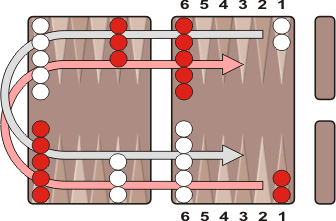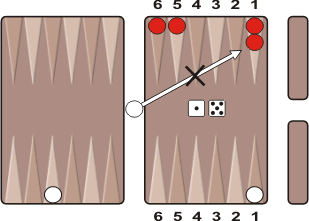![[Backgammon Galore!]](/gif/GaloreButton.gif)
|
|
Backgammon Variants Setup: The setup for Mexican backgammon is the same as regular backgammon.
Object: The object of the game is to move all of your checkers around the board to your own home table and then bear them off. The first player to bear off all of his checkers wins the game. To start: Each player rolls one die and the higher number goes first. That player may use the numbers just thrown or he may roll both dice again. After that, the players alternate turns. Movement: The roll of the dice indicates how many points, or pips, the player is to move his checkers. The following rules apply:
However, if you are unable to play all four numbers of a doubles roll, you lose the remaining numbers and do not get to roll again. Mexican: The roll of 1 and 2 is called a Mexican. If you roll a Mexican, here is what happens:
If the number you rolled again is another 1 and 2, you get to keep going. Note, however, if you are unable to use any part of your roll, you forfeit the rest of your turn. For example, if you can move your 1 but cannot use the 2, you may not name a double and you may not roll again. Hitting: A checker sitting alone on a point is called a blot. If an opposing checker lands on a blot, the blot is hit and placed on the bar. Entering from the bar: Any time you have one or more checkers on the bar, your first obligation is to reenter those checker(s) into the opponent's home board. You reenter a checker by moving it to an open point corresponding to one of the numbers on the rolled dice. If you are able to enter some but not all of your checkers on the bar, you must enter as many as you can then give up the remainder of your turn. The low-number-first requirement of Mexican makes entering checkers more difficult than in regular backgammon.
Exact bearoff: When all your checkers are home, you may commence bearing off. Checkers must be borne off exactly; that is, you may only remove checkers from the point numbers indicated by the roll. If you cannot bear off, you must make another legal move if possible within your home board. Scoring: The first player to bear off all his checkers wins the game. There is no bonus for a gammon or backgammon. There is no doubling cube in this game.
References
|
![]()
Backgammon Galore : Variants


